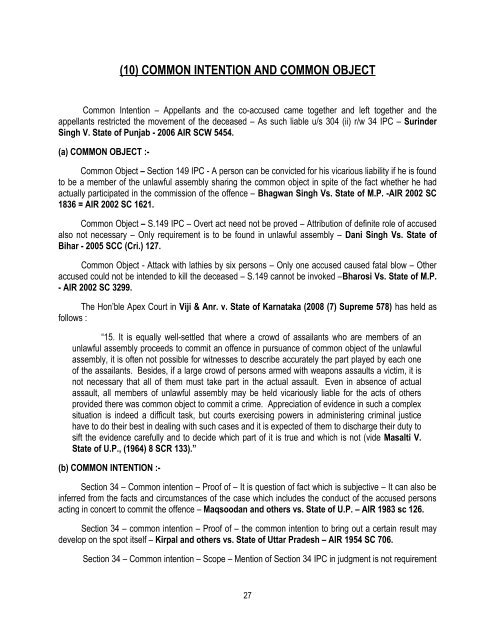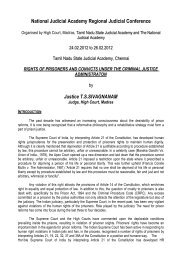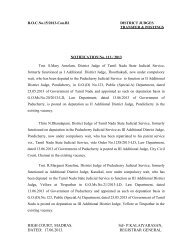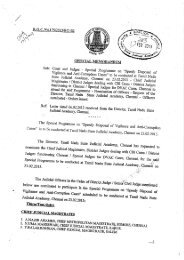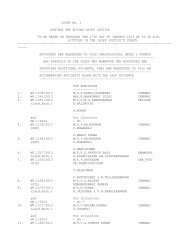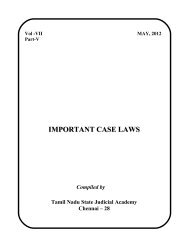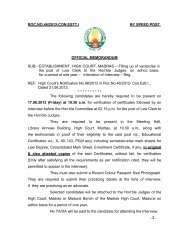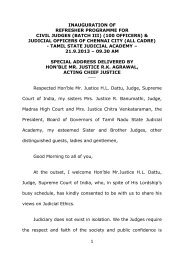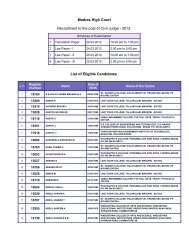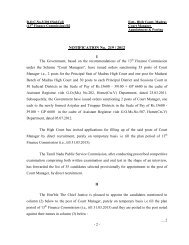Appreciation of Evidence in Sessions Cases - Justice D.Murugesan
Appreciation of Evidence in Sessions Cases - Justice D.Murugesan
Appreciation of Evidence in Sessions Cases - Justice D.Murugesan
Create successful ePaper yourself
Turn your PDF publications into a flip-book with our unique Google optimized e-Paper software.
(10) COMMON INTENTION AND COMMON OBJECT<br />
Common Intention – Appellants and the co-accused came together and left together and the<br />
appellants restricted the movement <strong>of</strong> the deceased – As such liable u/s 304 (ii) r/w 34 IPC – Sur<strong>in</strong>der<br />
S<strong>in</strong>gh V. State <strong>of</strong> Punjab - 2006 AIR SCW 5454.<br />
(a) COMMON OBJECT :-<br />
Common Object – Section 149 IPC - A person can be convicted for his vicarious liability if he is found<br />
to be a member <strong>of</strong> the unlawful assembly shar<strong>in</strong>g the common object <strong>in</strong> spite <strong>of</strong> the fact whether he had<br />
actually participated <strong>in</strong> the commission <strong>of</strong> the <strong>of</strong>fence – Bhagwan S<strong>in</strong>gh Vs. State <strong>of</strong> M.P. -AIR 2002 SC<br />
1836 = AIR 2002 SC 1621.<br />
Common Object – S.149 IPC – Overt act need not be proved – Attribution <strong>of</strong> def<strong>in</strong>ite role <strong>of</strong> accused<br />
also not necessary – Only requirement is to be found <strong>in</strong> unlawful assembly – Dani S<strong>in</strong>gh Vs. State <strong>of</strong><br />
Bihar - 2005 SCC (Cri.) 127.<br />
Common Object - Attack with lathies by six persons – Only one accused caused fatal blow – Other<br />
accused could not be <strong>in</strong>tended to kill the deceased – S.149 cannot be <strong>in</strong>voked –Bharosi Vs. State <strong>of</strong> M.P.<br />
- AIR 2002 SC 3299.<br />
The Hon’ble Apex Court <strong>in</strong> Viji & Anr. v. State <strong>of</strong> Karnataka (2008 (7) Supreme 578) has held as<br />
follows :<br />
“15. It is equally well-settled that where a crowd <strong>of</strong> assailants who are members <strong>of</strong> an<br />
unlawful assembly proceeds to commit an <strong>of</strong>fence <strong>in</strong> pursuance <strong>of</strong> common object <strong>of</strong> the unlawful<br />
assembly, it is <strong>of</strong>ten not possible for witnesses to describe accurately the part played by each one<br />
<strong>of</strong> the assailants. Besides, if a large crowd <strong>of</strong> persons armed with weapons assaults a victim, it is<br />
not necessary that all <strong>of</strong> them must take part <strong>in</strong> the actual assault. Even <strong>in</strong> absence <strong>of</strong> actual<br />
assault, all members <strong>of</strong> unlawful assembly may be held vicariously liable for the acts <strong>of</strong> others<br />
provided there was common object to commit a crime. <strong>Appreciation</strong> <strong>of</strong> evidence <strong>in</strong> such a complex<br />
situation is <strong>in</strong>deed a difficult task, but courts exercis<strong>in</strong>g powers <strong>in</strong> adm<strong>in</strong>ister<strong>in</strong>g crim<strong>in</strong>al justice<br />
have to do their best <strong>in</strong> deal<strong>in</strong>g with such cases and it is expected <strong>of</strong> them to discharge their duty to<br />
sift the evidence carefully and to decide which part <strong>of</strong> it is true and which is not (vide Masalti V.<br />
State <strong>of</strong> U.P., (1964) 8 SCR 133).”<br />
(b) COMMON INTENTION :-<br />
Section 34 – Common <strong>in</strong>tention – Pro<strong>of</strong> <strong>of</strong> – It is question <strong>of</strong> fact which is subjective – It can also be<br />
<strong>in</strong>ferred from the facts and circumstances <strong>of</strong> the case which <strong>in</strong>cludes the conduct <strong>of</strong> the accused persons<br />
act<strong>in</strong>g <strong>in</strong> concert to commit the <strong>of</strong>fence – Maqsoodan and others vs. State <strong>of</strong> U.P. – AIR 1983 sc 126.<br />
Section 34 – common <strong>in</strong>tention – Pro<strong>of</strong> <strong>of</strong> – the common <strong>in</strong>tention to br<strong>in</strong>g out a certa<strong>in</strong> result may<br />
develop on the spot itself – Kirpal and others vs. State <strong>of</strong> Uttar Pradesh – AIR 1954 SC 706.<br />
Section 34 – Common <strong>in</strong>tention – Scope – Mention <strong>of</strong> Section 34 IPC <strong>in</strong> judgment is not requirement<br />
27


